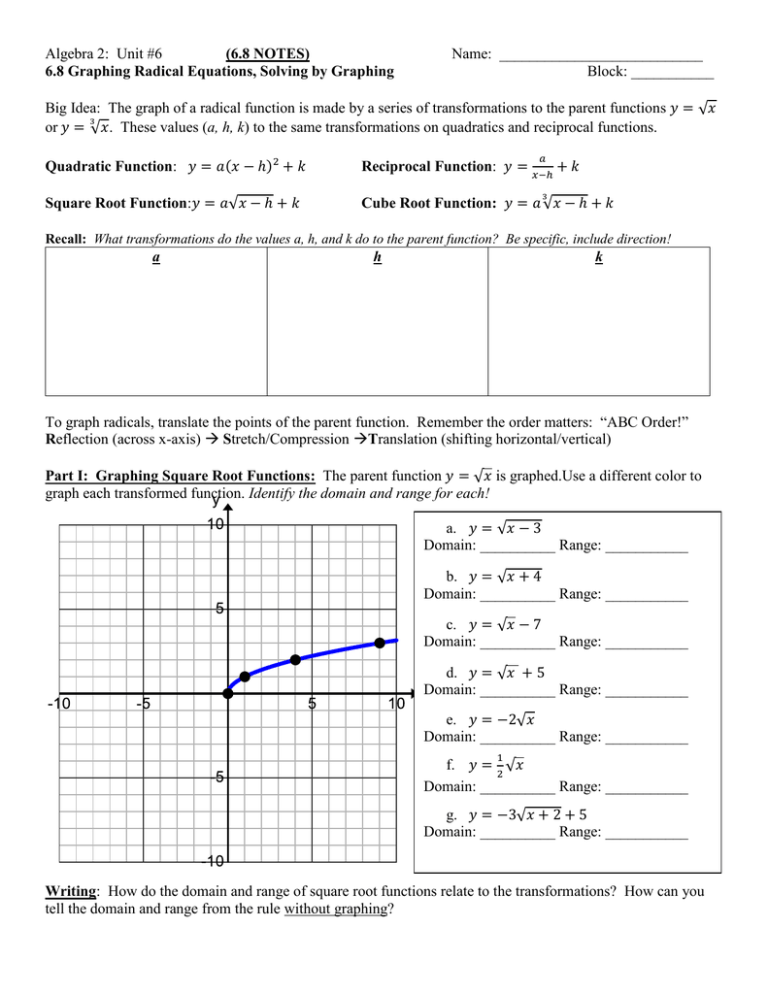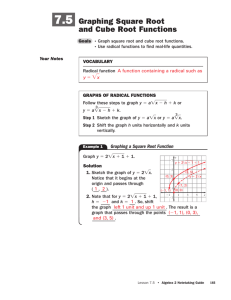Algebra 2: Graphing Radical Equations & Transformations
advertisement

Algebra 2: Unit #6 (6.8 NOTES) 6.8 Graphing Radical Equations, Solving by Graphing Name: ___________________________ Block: ___________ Big Idea: The graph of a radical function is made by a series of transformations to the parent functions 𝑦 = √𝑥 3 or 𝑦 = √𝑥. These values (a, h, k) to the same transformations on quadratics and reciprocal functions. 𝑎 Quadratic Function: 𝑦 = 𝑎(𝑥 − ℎ)2 + 𝑘 Reciprocal Function: 𝑦 = 𝑥−ℎ + 𝑘 Square Root Function:𝑦 = 𝑎√𝑥 − ℎ + 𝑘 Cube Root Function: 𝑦 = 𝑎 √𝑥 − ℎ + 𝑘 3 Recall: What transformations do the values a, h, and k do to the parent function? Be specific, include direction! a h k To graph radicals, translate the points of the parent function. Remember the order matters: “ABC Order!” Reflection (across x-axis) Stretch/Compression Translation (shifting horizontal/vertical) Part I: Graphing Square Root Functions: The parent function 𝑦 = √𝑥 is graphed.Use a different color to graph each transformed function. Identify the domain and range for each! a. 𝑦 = √𝑥 − 3 Domain: __________ Range: ___________ b. 𝑦 = √𝑥 + 4 Domain: __________ Range: ___________ c. 𝑦 = √𝑥 − 7 Domain: __________ Range: ___________ d. 𝑦 = √𝑥 + 5 Domain: __________ Range: ___________ e. 𝑦 = −2√𝑥 Domain: __________ Range: ___________ 1 f. 𝑦 = 2 √𝑥 Domain: __________ Range: ___________ g. 𝑦 = −3√𝑥 + 2 + 5 Domain: __________ Range: ___________ Writing: How do the domain and range of square root functions relate to the transformations? How can you tell the domain and range from the rule without graphing? Part II: Graphing Cube Root Functions: The parent 3 function 𝑦 = √𝑥 is graphed. Use a different color to graph each transformed function. Identify the domain and range for each! 3 a. 𝑦 = √𝑥 + 2 Domain: __________ Range: ___________ 3 b. 𝑦 = √𝑥 − 1 Domain: __________ Range: ___________ 3 c. 𝑦 = √𝑥 − 6 Domain: __________ Range: ___________ 3 d. 𝑦 = √𝑥 + 8 Domain: __________ Range: ___________ 13 e. 𝑦 = − 4 √𝑥 Domain: __________ Range: ___________ 3 f. 𝑦 = 5 √𝑥 Domain: __________ Range: ___________ 3 g. 𝑦 = −4 √𝑥 + 3 − 2 Domain: __________ Range: ___________ Writing: Why are the domain and range of all cubic functions the same? What other radical equations would have this domain and range? Part III: Solving a Radical Equation By Graphing (calculator allowed thank Baby Gabel!) On a graph, if two functions are equal, this will appear as an _______________________. In the table, his will look like ______________________________. Therefore, we can graph each side of an equation as a separate equation (Y1= ____ and Y2 = _____) and find this/these point(s)! A. √(𝑥 + 3) = 4√𝑥 − 2 3 B. √𝑥 − 1 = √𝑥 − 1 Part IV: Rewriting a Radical Function 3 Rewrite each function so that it is in the form 𝑦 = 𝑎√1𝑥 − ℎ + 𝑘 or 𝑦 = 𝑎 √1𝑥 − ℎ + 𝑘 using factoring, perfect squares/cubes, etc. Then describe all the transformations made to the parent function. C. 𝑦 = √36𝑥 − 72 + 4 3 D. 𝑦 = √−8𝑥 − 32 − 2 𝑥+7 E. 𝑦 = √ 16 + 3 Bookwork: page 418: For #17-20 (just describe the transformations), then do #21-23, 33, 35, 36, 45, 46, 49, 52, 60




